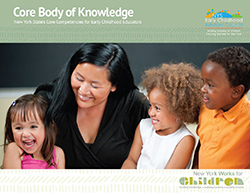
Core Body of Knowledge
New York State's Core Competencies for Early Childhood Educators

1.7
Resources for Competency 1.7:
2
click to view resource list
English Language Learners
The professional working with young children encourages and supports English Language Learners
Resources & Media for Understanding Competency 1.7
Behaviors & Skills
-
aProvides opportunities for children to experience oral and written communication in a language that their family uses and understands
-
bHelps children to see that knowing more than one language is an asset
-
cProvides meaningful ways for children to develop competence with the English language
-
dSupports continued development of the primary language
-
eRespects differences in culture and language as difference, rather than deficiencies
-
fRespects individual differences in language-learning style
-
gMakes adjustments and/or provides the support necessary to help the bilingual/multilingual child succeed:
- Appropriately uses props, visual aids, and body language
- Labels objects and materials in English and the child's primary language
- Uses repetition, pauses, short sentences, and frequent comprehension checks
- Designates a classroom peer to help the bilingual/multilingual child find materials and resources
- Uses role play and cooperative group work to increase communication opportunities
- Accepts children's best effort to communicate in the second language
- Provides descriptions of what the bilingual/multilingual child is doing
- Allows the bilingual/multilingual child to observe without the pressure to respond


